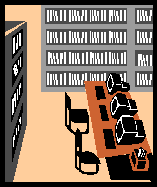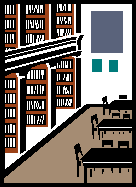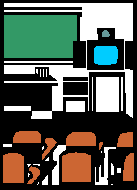Plagiarism Workshop
A Hotlist & Lesson Plan for 9 - 12
th Grade (Interdisciplinary Library Skills/
English/Social
Studies)
Designed by Janice Cooper
Northern Valley Regional High School
Old Tappan, NJ
07675
cooper_j@nvnet.org

Overview | Materials | Workshop Hotlist | Workshop Outline | Additional Resources | Standards | Credits & Thanks
Overview
This one-hour workshop is intended to give high school students:
- an introduction to the issue of plagiarism,
- an overview of copyright laws and fair use provisions
- a demonstration of techniques to avoid plagiarism, focusing on paraphrasing, quoting, and citing sources.
Presented here as an outline, this workshop can be expanded or contracted to meet time constraints, and student interest, concern, or grade level.
Materials Needed
- Demonstration computer with projector
- Copies of handouts from Laura Kaemming's Copyright Lesson
Plan
http://www.cyberbee.com/copyrpln.pdf
- Copyright Worksheet (page 7 of pdf lesson plan)
- Copyright (pages 3 + 4 of pdf lesson plan)
- Fair Use (pages 5 + 6 of pdf lesson plan)
- Copies of Steven Ambrose's Citizen Soldiers and Wild
Blue
- Copies of guide from Purdue University's OWL: Avoiding
Plagiarism http://owl.english.purdue.edu/handouts/print/research/r_plagiar.html
(5 pages)
- Copies of printouts of David Gardner's Plagiarism Lesson
Plan
http://ec.hku.hk/plagiarism/introduction.htm
"Self-Test:" Source Text A, Source Text B, Student Text 1, and Student Text 3
- List of Internet sites in "Workshop Hotlist" below.
Workshop Hotlist
Bookmark the Internet sites to be accessed in advance or project this hotlist during the workshop itself.
I. Copyright Lesson Plan by Laura Kaemming http://www.cyberbee.com/copyrpln.pdf
II.
Copyright With Cyberbee http://www.cyberbee.com/cb_copyright.swf
III.
Copyright Website
http://www.benedict.com/
IV. National Public
Radio (NPR) "All Things Considered" http://discover.npr.org/features/feature.jhtml?wfId=1136141
V.
Avoiding Plagiarism from Purdue University's OWL
http://owl.english.purdue.edu/handouts/print/research/r_plagiar.html
VI.
Plagiarism And How to Avoid It by David Gardner http://ec.hku.hk/plagiarism/introduction.htm
Workshop Outline
I. Opening Activity
Copyright Lesson Plan by Laura Kaemming
http://www.cyberbee.com/copyrpln.pdf
This online lesson plan was designed for 8th grade students to be
implemented over the course of several days. It guides students in
grappling with the complex issues underlying copyright laws. If time
allows, it is an excellent lesson. Kaemming's worksheets used for this
workshop summarize the laws clearly and briefly.
- Copyright Worksheet
Distribute worksheet to students as they enter. - Discuss questions as an icebreaker.
- Discuss ramifications of taking/using as artist's work. Recording companies won't support new artists or give them exposure. However, Internet may be best venue for exposing new artists' work and generating an audience.
- Very complicated issues.
Copyright Law - Distribute, read, and discuss overview of copyright laws, noting exclusivity of use, performance, and spin-offs of work.
- Focus on length of copyright coverage included on second
page.
Fair Use
- Discuss teachers' use of video in classrooms.
- Distribute overview of Fair Use.
- Discuss Fair Use as a balance between the needs of the producers and
the consumers.
II. Copyright Overview
Website
Copyright With Cyberbee http://www.cyberbee.com/cb_copyright.swf
The Cyberbee site has a wealth of information on copyright. The page
listed below will introduce the students to the issues involved with the
use of copyrighted materials for the reports and projects they are likely
to create.
- Project the website.
- Although a cartoon, this site gives a concise overview of use of
copyrighted materials in educational settings. Roll over student figures
to read questions. Click on students to get answers.
III. Media Examples Website
Copyright Website http://www.benedict.com/
This intriguing Internet site features examples of plagiarism in many different media or formats. The two or three selected for this workshop focus the students' attention on the artists' perspective. Students are fascinated with this site.
- Access the website.
- Click on "Audio," view and discuss audio examples from Vanilla Ice's
"Ice Ice Baby" and Queen's "Under Pressure." (Listening to the first 30
seconds or so is sufficient for discussing the first audio example.)
- If time allows, do same with George Harrison's "My Sweet Lord" and
the Chiffons' "He's So Fine" for a more subtle example of inadvertent
plagiarism.
- Return to main page, click on "Visual," view and discuss use of
Frederick Hart's sculpture in the film "Devil's Advocate."
- If time allows, do same with Batman example.
- As the original artist, how would you feel?
IV. Plagiarized Writing
Example
NPR "All Things Considered"
http://discover.npr.org/features/feature.jhtml?wfId=1136141
This website links to a January 2002 interview focusing on
plagiarism. It opens with simultaneous readings of the original passages
and Steven Ambrose's plagiarized ones. This recording makes a strong
statement and is a nice transition between art examples and the following
discussion on avoiding plagiarism.
- Access the website.
- Click on icon to play recording. (The first 1 minute and 30 seconds
should be sufficient, providing three separate, brief passages.)
- Again, how would you feel as the original writer of the
passages?
- Discuss possible reasons for inadvertent plagiarism Ambrose
articulated: researchers were sloppy with notetaking and editors may
have been lax with printing documentation.
- Discuss loss of academic credibility and integrity, destruction of
reputation and life's work (and loss of income as minor but practical
aspect).
- (Mention plagiarism connected to Doris Kearns Goodwin so Ambrose
doesn't appear as an isolated case.)
- Discuss student penalties for plagiarism, especially college
students: expulsion, mark on student record, no tuition money
back.
V. Academic Writing and Plagiarism
Avoiding Plagiarism OWL (Purdue University's Online Writing
Guide)
http://owl.english.purdue.edu/handouts/print/research/r_plagiar.html
The OWL writing guides are wonderful resources. Two more are listed below under "Additional Resources" that provide detailed information on paraphasing, quoting, and citing.
Read or summarize, all or parts of this guide in the workshop as appropriate for the age / level of the students and their current research projects. For 9th grade students, focusing on the spectrum of plagiarism activities might be sufficient before moving to the plagiarism lesson.
- Distribute copies of Avoiding Plagiarism.
- Project the website.
- Scroll down and read through "Contradictions of American Academic
Writing Section."
- Read through "Actions that might be seen as plagiarism" section.
- Lead students through "Choosing When to Give Credit," highlighting
the concept of 'common knowledge.'
- If time allows, direct students to the "Making Sure You Are Safe"
section detailing techniques for note taking.
- How do you avoid committing plagiarism?
VI. Plagiarism Lesson
Plagiarism And How to Avoid It by David Gardner
http://ec.hku.hk/plagiarism/introduction.htm
A well-designed online lesson, Plagiarism And How to Avoid It was written for college students. It is useful and accessible for high school students as well. The informational pages are short, to the point, and can be easily summarized while they are projected for the workshop. The writing samples are easily understood and interesting. If time allows, advanced students can read more "student samples" or work through the lesson "self-test" in groups, as the author intended.
Writing guides included under "Additional Resources" will provide more examples and specific instructions on paraphrasing and quoting.
- Access the website and open lesson to the "introduction." Read
definition. Discuss meaning of plagiarism. (The origin of the word is
"to kidnap.")
- Read through "Techniques," focusing on paraphrasing and quoting.
- Read through examples on "Opinion" page.
- Briefly review techniques for citing and creating bibliography on
"Reference" page.
- (Refer students to online handbook for details on formats the high
school requires.)
- Hand out copies of "Self-Test" pages: Source Texts A and B, and
Student Samples 1 and 3.
- Request volunteers or read aloud the first two paragraphs of Source
Text A and the first paragraph of Source Text B.
- Request volunteers or read aloud the first paragraph from each of
the Student Samples 1 and 3.
- Discuss copying, paraphrasing, citations, use of opinion verbs, and
quality of student pieces.
VII. Conclusion
Yes, technology makes plagiarism possible. No, that doesn't make it
right. The onus is not on the teacher to catch the student committing
plagiarism; the onus is on the student not to commit it.

Additional Resources
I. Plagiarism Guide
- On Plagiarism: What is Plagiarism?
http://www.2learn.ca/mapset/SafetyNet/plagiarism/handout2.html
A two page overview of the problem of plagiarism in education
II. Writing Guides
Guides developed by college and university writing centers provide some of the most concise information on plagiarism and help on how to avoid it.
- OWL Guide Quoting, Paraphrasing, and Summarizing http://owl.english.purdue.edu/handouts/print/research/r_quotprsum.html
A four page guide that compares and contrasts the three methods of using information and sample exercises.
- OWL Guide Paraphrase: Write it in Your Own Words
http://owl.english.purdue.edu/handouts/print/research/r_paraphr.html
A concise two page introduction to paraphrasing.
- Plagiarism: What It Is and How to Recognize and Avoid
It
http://www.indiana.edu/~wts/wts/plagiarism.html
A three and a half page guide to plagiarism with specific examples of acceptable and unacceptable quoting and paraphrasing.
- How to Use Sources and Avoid Plagiarism
http://www.wlu.ca/~wwwwc/handouts/sources.htm
A two and a half page introduction, this guide provides concise examples of how to summarize, paraphrase, and quote.
III. Copyright FAQs
If you still have questions pertaining to copyright and fair use, check
to see whether they have been answered at these frequently asked question
sites.
- Copyright Law: Who Needs It?
http://www.copyright.com/CopyrightResources/default.asp
A straightforward site that answers eleven basic questions about copyright
- 10 Big Myths About Copyright Explained
http://www.templetons.com/brad/copymyths.html
A seven page site that tackles major questions about copyright in a conversational tone.
IV. Copyright in Schools
- Intellectual Property in the Information Age: A Classroom Guide
to Copyright http://www.cas.usf.edu/english/walker/papers/copyright/ipdummie.html
A four page guide to copyright law as it pertains to the classroom.
- The Educator's Guide to Copyright
http://www.educationworld.com/a_curr/curr280.shtml
A lengthy guide for teachers on all aspects of copyright and fair use, particularly as it applies to new technologies.
V. Copyright Website
If the overviews and FAQs of copyright laws do not answer your specific
questions, look at the official website.
- U.S. Copyright Office
http://lcweb.loc.gov/copyright/

Standards
New Jersey Department of Education
http://www.state.nj.us/njded/cccs/02/
New Jersey Core Curriculum Content Standards:
- Cross-Content Workplace Readiness
Standard 1: All students will develop career planning and workplace readiness skills.
Standard 2: All students will use technology, information and other tools.
Standard 3: All students will use critical thinking, decision-making, and problem-solving skills.
Standard 4: All students will demonstrate self-management skills.
- Visual and Performing Arts
Standard 1.1: All students will acquire knowledge and skills that increase aesthetic awareness in dance, music, theater, and visual arts.
- Language Arts
STANDARD 3.1 (READING) ALL STUDENTS WILL UNDERSTAND AND APPLY THE KNOWLEDGE OF SOUNDS, LETTERS, AND WORDS IN WRITTEN ENGLISH TO BECOME INDEPENDENT AND FLUENT READERS, AND WILL READ A VARIETY OF MATERIALS AND TEXTS WITH FLUENCY AND COMPREHENSION.
H. Inquiry and Research
4. Read and critically analyze a variety of works, including books and other print materials (e.g., periodicals, journals, manuals), about one issue or topic, or books by a single author or in one genre, and produce evidence of reading.
5. Apply information gained from several sources or books on a single topic or by a single author to foster an argument, draw conclusions, or advance a position.
STANDARD 3.2 (WRITING) ALL STUDENTS WILL WRITE IN CLEAR, CONCISE, ORGANIZED LANGUAGE THAT VARIES IN CONTENT AND FORM FOR DIFFERENT AUDIENCES AND PURPOSES.
A. Writing as a Process (prewriting, drafting, revising, editing, postwriting)
3. Analyze and revise writing to improve style, focus and organization, coherence, clarity of thought, sophisticated word choice and sentence variety, and subtlety of meaning.
7. Reflect on own writing and establish goals for growth and improvement.
B. Writing as a Product (resulting in a formal product or publication)
6. Write a literary research paper that synthesizes and cites data using researched information and technology to support writing.
7. Use primary and secondary sources to provide evidence, justification, or to extend a position, and cite sources from books, periodicals, interviews, discourse, electronic sources, etc.
D. Writing Forms, Audiences, and Purposes (exploring a variety of forms)
4. Apply all copyright laws to information used in written work.
- Social Studies
Standard 6.2: All Students Will Learn Democratic Citizenship Through The Humanities, By Studying Literature, Art, History And Philosophy, And Related Fields.
Standard 6.6: All Students Will Acquire Historical Understanding Of Economic Forces, Ideas, And Institutions Throughout The History Of New Jersey, The United States, And The World.
Credits & Thanks
Thank you to the authors and webmasters of the Internet sites listed in this workshop for graciously allowing me to link to their websites, either by email response or by explicitly permitting links on their "terms of use" pages.
Special thanks to:
- Becky Mather, University of Northern Iowa, for initiating my
interest in copyright issues.
- Lois Wilkins, Sussex County Technical School, for her inspiring
presentation to EMAnj in October, 2002 and sharing her copyright
information.
"We all benefit by being generous with our work. Permission is hereby granted for other educators to copy this workshop, update or otherwise modify it, and post it elsewhere provided that the original author's name is retained along with a link back to the original URL of this Web workshop. On the line after the original author's name, you may add Modified by (your name) on (date). If you do modify it, please let me know and provide the new URL."
Last updated on 7/28/03. Based on a template from The WebQuest Page

